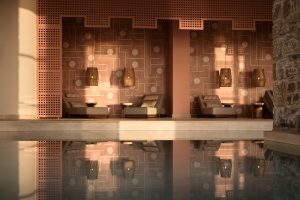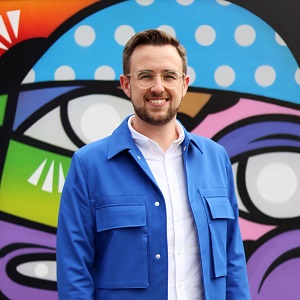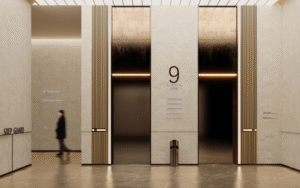Digging deeper into materiality and discovering the relationship between luxury, creativity and sustainability in hotel design, Editor Hamish Kilburn sat down with seven leading designers to get a grip on what materials matter in hotel design. Pauline Brettell writes…

Surrounded by the innovative use of materials running through the design of the Squire & Partners was unquestionably an appropriate setting for this roundtable conversation – inside a dome structure, overlooking London’s skyline. What’s more, the honest dialogue between leaders of the design community took place an hour before the venue opened its doors and Hotel Designs hosted MEET UP London.
With a backdrop of stripped back surfaces contrasting with (luxurious) finishes, the panel discussed not only the materials, but also the matter and mode of manufacture and why this does in fact matter! Discussion covered questions of material innovation and development, notions of luxury, locality and sustainability within the shifting boundaries of hospitality – all in the process of getting a better understanding on where this path is leading design, or is it where design is leading the development of materials?
On the panel:
With a plethora of research being done around new materials for the construction and design industry – including products like graphene, hempcrete and even microalgae – in reality, how close are we to using some of these materials in design over other traditional ones in projects? The conversation started off right on point, by looking at what new products are not only available, but are actually fit for purpose and being put to practical use in projects. Can in fact the use of innovative materials transport a project, as well as making meaningful materials more accessible across the design board?

Image credit: Studio Moren
Hamish Kilburn: In reality, how close are we to using some of these materials in general architecture/design over other traditional ones in projects?
Maria Cheung: We are using Graphenstone paint right now in projects, which is a wonderful success story, as it is a product that is actually a practical and viable alternative. A mix of natural lime-based paint with graphene technology, it provides a durability and ticks all the sustainability boxes along with the aesthetic ones and practicality of application. Considering the thousands of metres of paint designers specify in commercial projects, this is a really exciting and practical material development, that can actually make a difference.
Lucy Bagshaw: There are so many exciting material and product innovations that as designers we see and discover at trade fairs and via suppliers, only to find when it comes to specifying them, they are either not suited to commercial application or, importantly, not tested for purpose. As designers, especially working in commercial and hospitality arena we are constantly faced with regulation and specification issues and we need to keep pushing to encourage suppliers to not only develop the products but take it that step further, do the testing and make it a viable option to specify.
David Harte: The reality is, is that the creative force in developing alternative materials often comes from smaller companies These creative small businesses often find it more difficult to move a product forward and get it up and running and tested for use for commercial interiors.

Image credit: Studio Moren / Jack Hardy
HK: How much of the progress in developing alternative materials is in coming from other industries, for example the fashion industry?
MC: Waste product from the fashion industry is clearly coming into our material supply chain. A few years ago, we saw a beautiful surface product called Really, which was developed from recycled denim, but it wasn’t, at the time a practical option for interior specification. However, the manufacturers took the feedback on board and have, over time, been able to produce a hard wearing, scratch resistant worktop, that is both beautiful and fit to purpose.
Constantina Tsoutsikou: Ensuring materials can be specified for the contract market definitely takes time and it is often the last step in the process of research and development. Unfortunately, once that is done, what started out as a sustainable product often becomes less so to make sure it is fire retardant, anti- slip and all the other regulations that need to be met.

Image credit: Studio LOST
While it is clear that there are some commercial success stories out there, many of the new and innovative products exploring alternative materiality remain a work-in-progress. Designers around the table agreed that it was key that collaboration between designers and suppliers is essential to keep pushing the process forward until both the creative and the practical elements join forces in what then becomes a successful product that functions well, looks good and ticks sustainable boxes. This means keeping an eye on the long-term vision and can be a process involving time, conversations and collaborations.
HK: As expectations of the hotel experience both shift and accelerate, it is key to understand these shifts and how materiality plays into it. Is in fact materiality the new luxury as luxury brands focus on feeling rather than just a finish?
David Harte: Tactility is what people really engage with – luxury is a feeling rather than a finish. It is a sense that can be created through design and the elements you interact with.
Brigitta Spinocchia Freund: Design is about approaching materials differently and understanding how this relates to what people are ultimately looking for from a hotel experience now. Across our projects, we explore and introduce concepts of spirituality in design and this can come across in many different ways – locality and sustainability are certainly part of that conversation, as is the carbon footprints of a product and a design. People are also looking for more now in terms of a hotel experience and materials need to evoke feelings.

Image credit: Spinocchia Freund
HK: With this shift in expectations, can materials then help to define a brand in hotel design? Are brands in fact open to exploring alternative paths and materials to communicate the same brand message by using a new vocabulary?
Jennifer de Vere-Hopkins: Risks are not necessarily being taken at the luxury level yet – lifestyle, mid-market and commercial clients seem to be more open to innovation or exploring unproven products. The aim to be net zero can sometimes involve taking a chance and in our experience, commercial clients are more open to that innovation and the element of risk that comes with it. To some brands, maintaining luxe means perfection, so materials need still to look new and fresh over time. Embracing longevity in materials involves an acceptance of patina and imperfection.
MC: Mid-level brands are maybe a bit more adventurous, being less concerned with perfection than a luxury brand. While there are still brand guidelines in place, there are usually elements for us as designers to play with. Working on a Ruby Hotel for example, there are quite specific brand guidelines, but there is still room for some design dialogue in the public areas, which allows us to interpret and reflect the location. Hopefully the result is about the brand but also, importantly, about the design collaboration between brand guideline and the local project-based designers.
CT: In the luxury segment, brands tend to look for similar touch points. The wording may sound similar– comfort, warmth, luxury – but then we interpret them differently across the brands and through the design details.

Image credit: Jestico + Whiles
Taking the conversation further, having noted that there is still some reluctance in the luxury market to explore alternatives that are not yet tried and tested, can designers persuade clients to move away from the use of materials that come with high carbon costs? What are the touchpoints that can swing a conversation? While price point certainly remains an issue, if the sustainable and ethical threads can be woven into the design narrative by the designer and the client can see enough value in the story, they might be tempted to go there. The role of the designer is integral to providing the client with both the information and narrative.
LB: Everyone loves to tell a story and if a client can see enough value in the story behind a sustainable product or material, then they are usually more likely to get on board the idea of lowering the carbon footprint – although the concept of carbon and carbon footprint still needs to be communicated in a tangible and relatable way.
BSP: As a designer, if you can come up with a story behind a material – the artisans, how it was created, its sustainable story – operators see the value of the story behind the product and are in fact proud to share the narrative behind a product. Design is increasingly becoming about the story and this can be used to shift the balance in terms of materials used.
CT: We are also finding that it can sometimes be almost halfway through the process before actual materiality is shared and the client gets to experience and understand the materials in real life rather than via zoom or renders. Those meetings when the client is able to touch and feel the texture of materials are completely different and are often the point when materiality can win over other considerations like budget.
MC: It is great to find a material that sums up a project and gets the client onboard with the design vision. We recently developed a project around the concept of tide along the River Thames, incorporating tones and textures of rusted metals from the river banks. Finally, after a process of collaboration and conversation, Based Upon developed a material for us that worked on an aesthetic level in the design, as well as on a practical level for the client which was really exciting.
HK: There are a lot of brands out there that are using recycled plastic and creating statement pieces with character. Plastic has its connotations for not being luxurious. By looking at what is on the market today, can you see this changing?
MC: What actually defines luxury today is key to the question and one of the things that elevates a product is the level of craft involved. It is about the time and talent spent transforming a material into something beautiful. You can do that with plastics, the designs using ocean waste by furniture designer Brodie Neill being a case in point.
Jorge Hernandez: In the past recycled material have sometimes been a bit in your face with regards to plastic being the base product. What we are seeing now, as we continue to engage in the development process of materials, is a more understated use of the base product in materials like engineered leather and solid surfaces. While this is more about engineering than creativity, understated sustainability is becoming more common practice in the development of materials.

Image credit: Bathroom Brands Group
HK: Over the last few years, manufacturers have answered calls from the industry for more variety – bathrooms specifically when it comes to different finishes available. Has this changed the role of bathrooms from being practical spaces to being more driven by experience?
DH: The boundaries are definitely shifting and in some cases, disappearing as the bathroom comes right into the guestroom. This is definitely a credit to what is on the market from suppliers that we can do this and allows designers to make the bathroom a more inviting and design-led space as opposed to being separate and purely functional. It is rare to be asked to design a bathroom as a single entity now as both the bedroom and the bathroom constitute the guestroom experience.
JH: As bathroom product designers we are constantly exploring materiality in the bathroom – looking for innovations to make within the space and exploring the materials that will drive design forward. We need to ensure that designs and materials evolve both in terms of functionality and sustainability. The challenge is working with different material to get different finishes across the line to be able to crossmatch products and provide a broad range of design solutions.
Squire & Partners was the Exclusive Style Partner at MEET UP London. Bathroom Brands Group, which also supported this roundtable, is one of our Recommended Suppliers and regularly features in our Supplier News section of the website. If you are interested in becoming one of our Recommended Suppliers, please email Katy Phillips.
Main image credit: Studio LOST
































